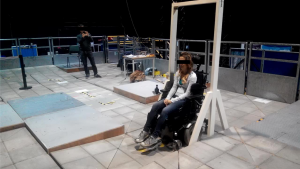ISI4NAVE is an Associate Team between INRIA project-team Rainbow (Rennes), Aspire CREATe (UCL – London), Rehabilitation Center of Pôle Saint Hélier (Rennes) and LGCGM lab, funded from 2016 to 2021.
General description
The ISI4NAVE associate team has been renewed in 2019 for 3 more years. During firt 3-year period, we proposed efficient indoor / outdoor obstacle avoidance systems that respect the user intention, and does not alter user perception. To this aim, we first embedded innovative sensors to tackle the wheelchair navigation problem in a human environment. We then take advantage of the proposed assistive tools to enhance the user Quality of Experience by means of basic feedback devices.
For the 2019/2021 period, we propose to develop adapted interfaces that should improve the understanding of people who suffer from cognitive and/or visual impairments. The originality of the project is to continuously integrate medical validation as well as clinical trials during the scientific research work in order to match user needs and acceptation.
Research directions
This project focuses on two main complementary objectives:
- to compensate both sensorimotor disabilities and cognitive impairments by designing innovative and adapted interfaces,
- to enhance the driving experience and to bring a new tool for rehabilitation purposes by defining efficient physical Human-Robot Interaction.
To assess the proposed solutions, we envisage performing clinical tests and case studies throughout the project in order to ensure compliance with user needs and acceptability.
The realization of this project requires five main tasks:
- definition and design of interfaces adapted to neurological diseases (mechatronics and robotics issues), e.g haptic interfaces, tactile interfaces, BCI, wearable haptics…
- definition of control strategies while using interfaces defined in task 1;
- definition of feedback devices;
- definition of a methodology related to clinical trials for evaluating both the system and the medical condition of the wheelchair user;
- experiments within the PAMELA Lab in UCL and clinical trials within the Pôle Saint Hélier.
Challenges
In order to ensure a widespread use of robotic systems, innovative interfaces, enabling relevant feedback (medically validated), constitute a major challenge. Trajectory corrections, obtained thanks to an assistance module, will have to be perceived by the user by means of sensitive (visual, tactile…) feedback that will have to be easily adapted to the pathology. Conversely, user interaction with the robotic system can be interpreted to control the wheelchair. Designing such systems require a multidisciplinary study, including medical data collection and analysis. To envisage a future transfer of the proposed technologies, design of pragmatic and cost efficient solutions remain a challenge that will be addressed in this ISI4NAVE Associate Team.
Methodology
Naturally, the proposed assistance solutions have to be compliant with both user needs and medical advice. The Pôle Saint Hélier is specialized in the rehabilitation of disabled people suffering from neurological diseases and has designed rigorous methodologies related to clinical trials. From this, the idea is to determine relevant measures that can characterize medical conditions of the patient who navigates with the proposed robotized wheelchair and adapted interfaces. These objective measurements should help the medical staff to evaluate the evolution of a given pathology as well as the relevance of the proposed feedback solutions.




